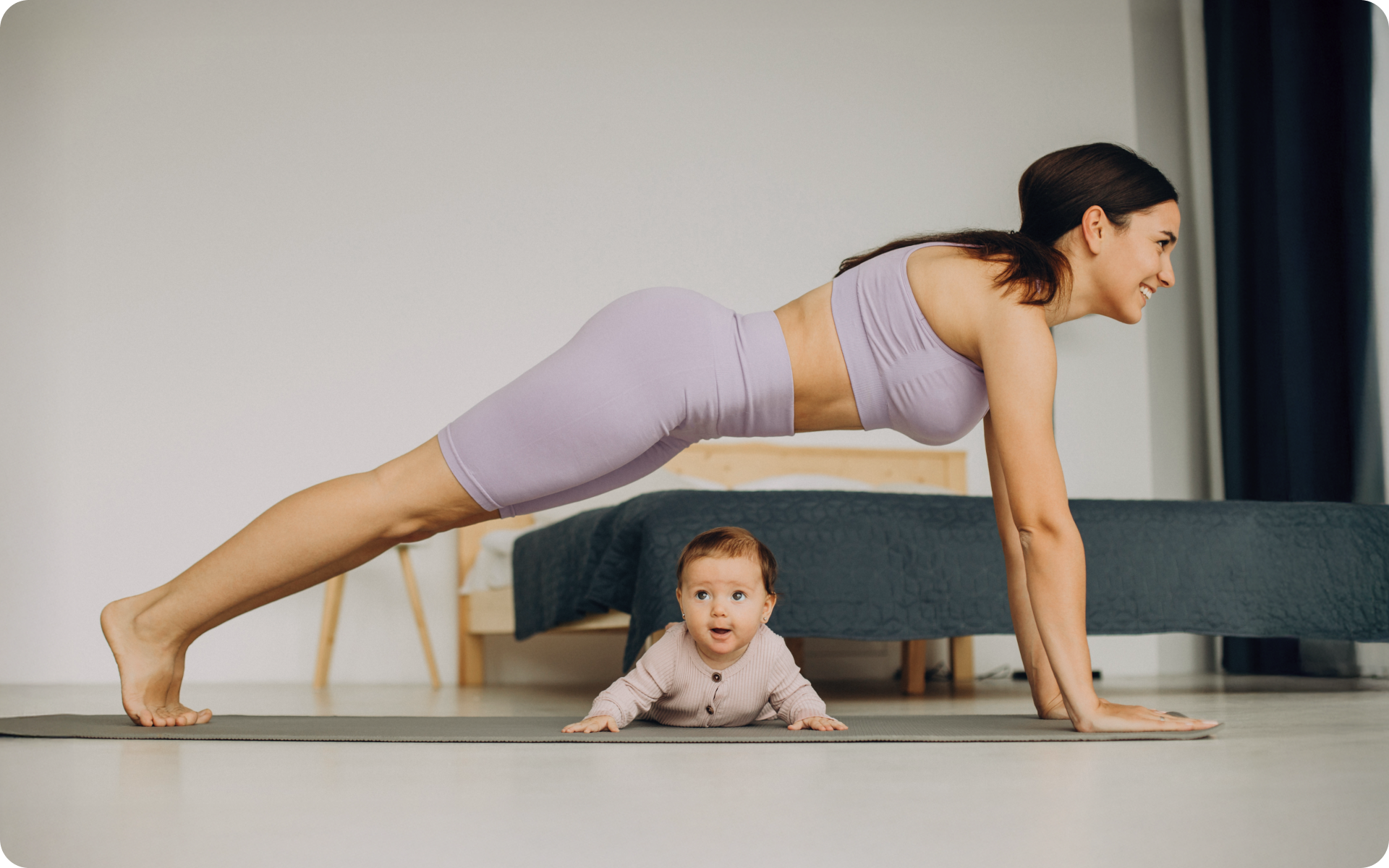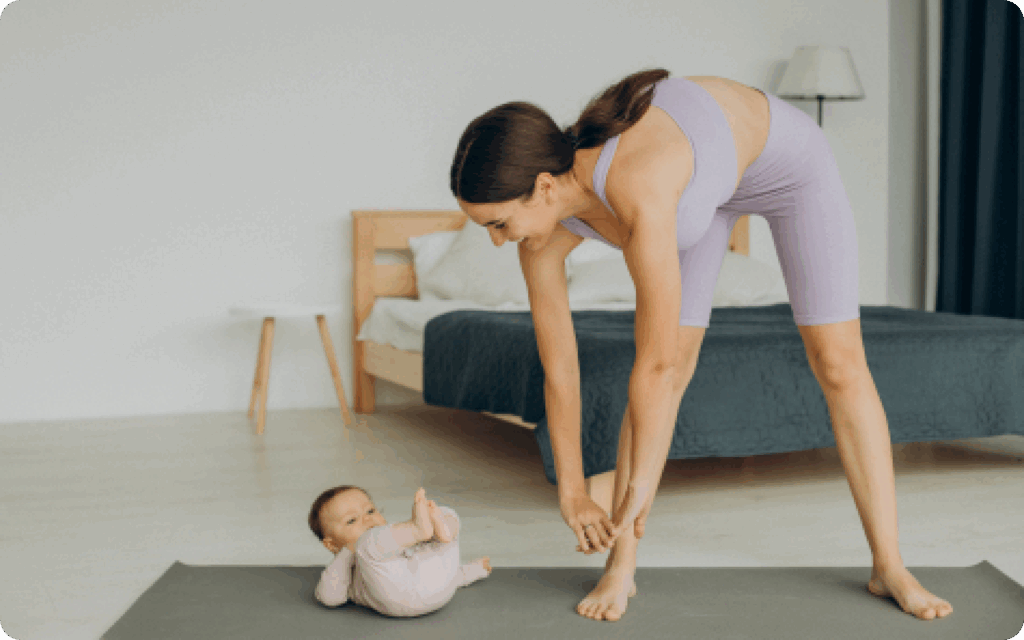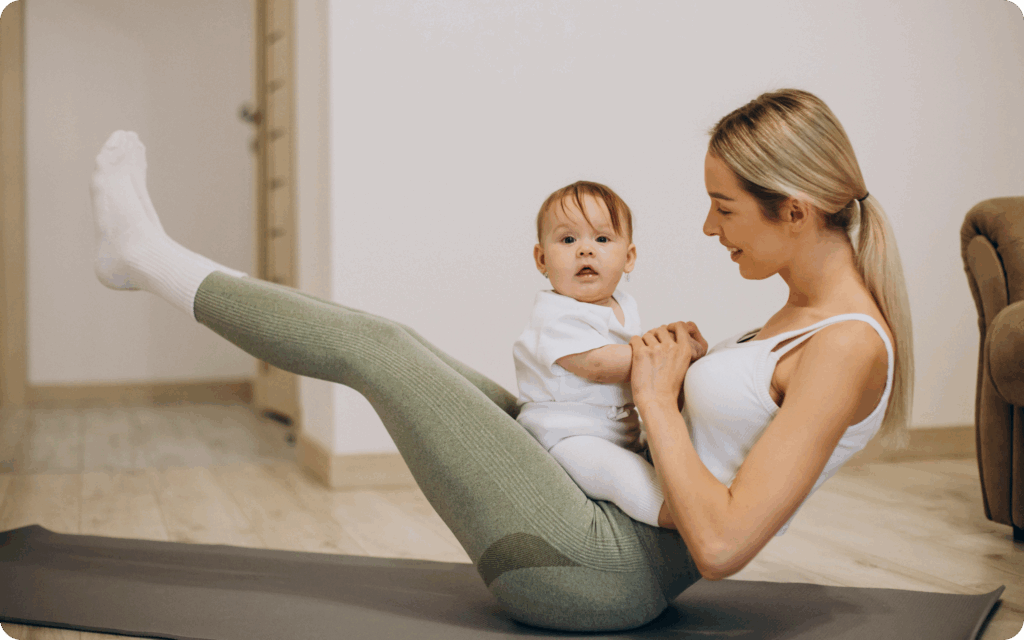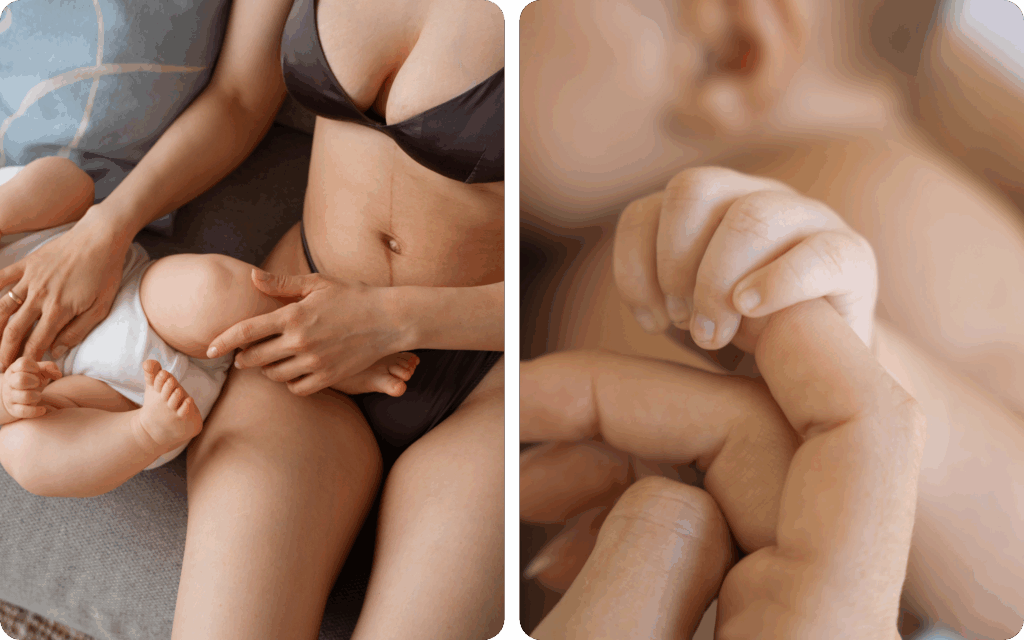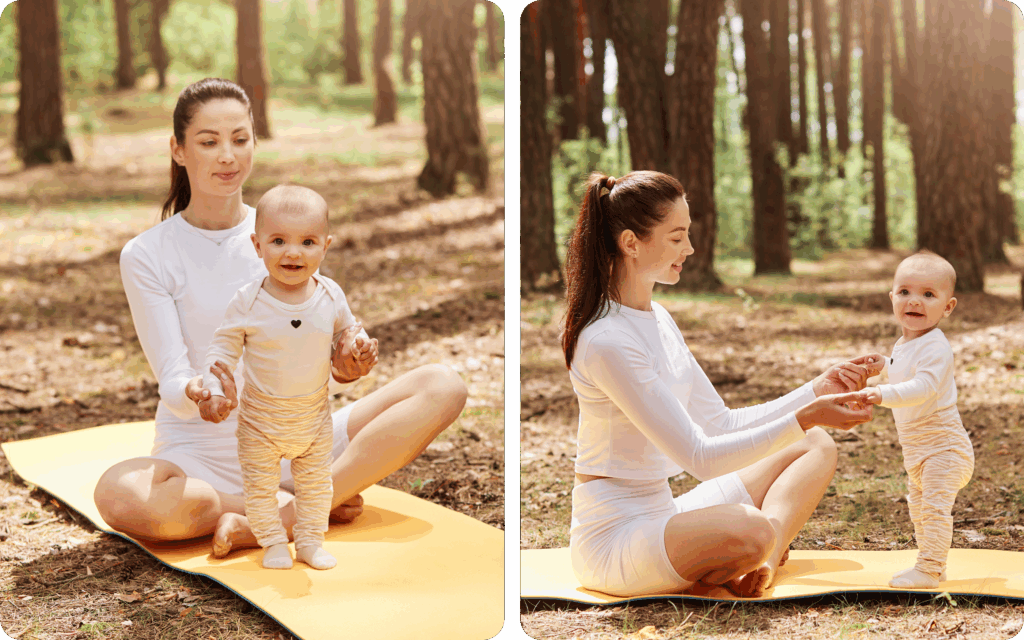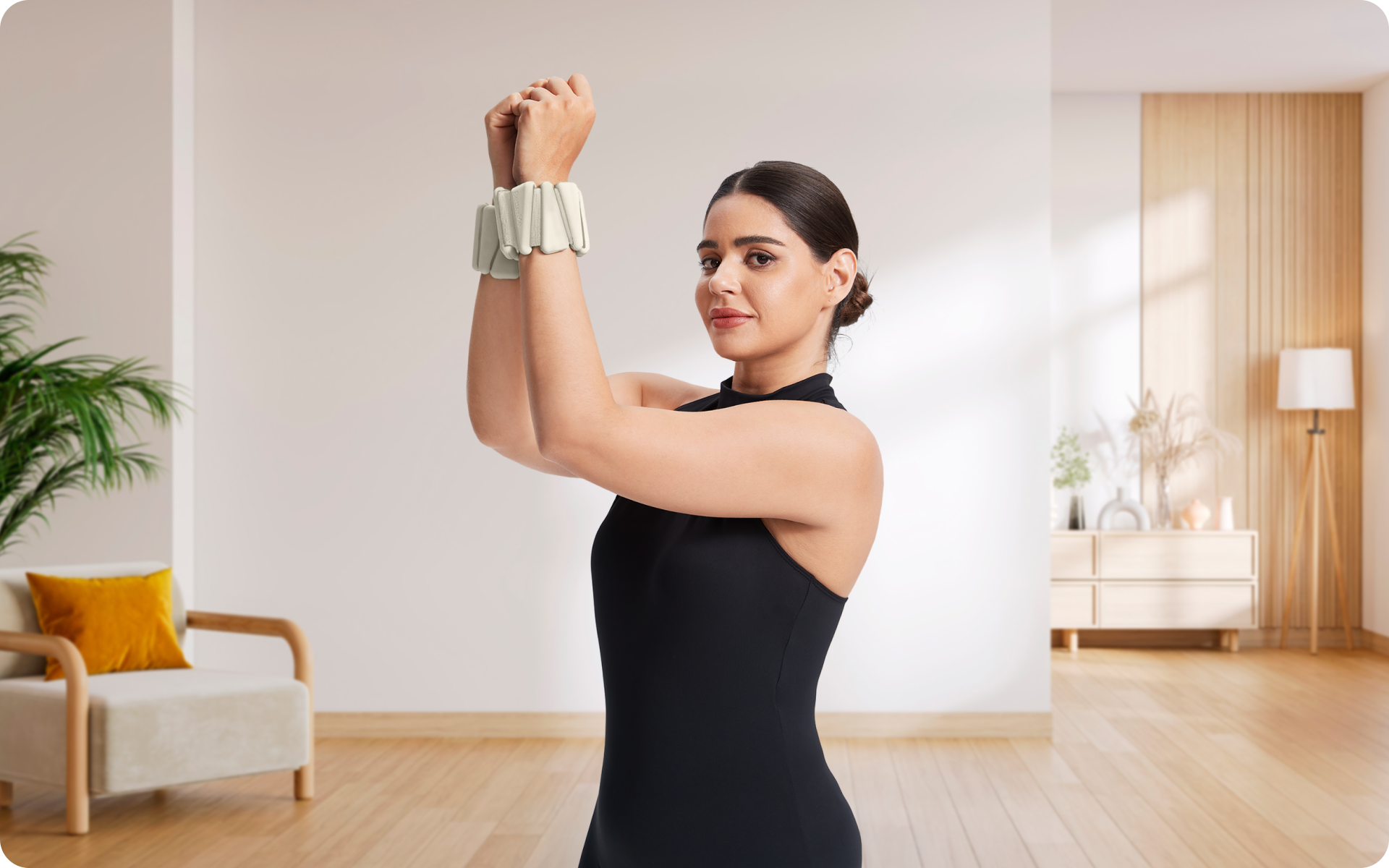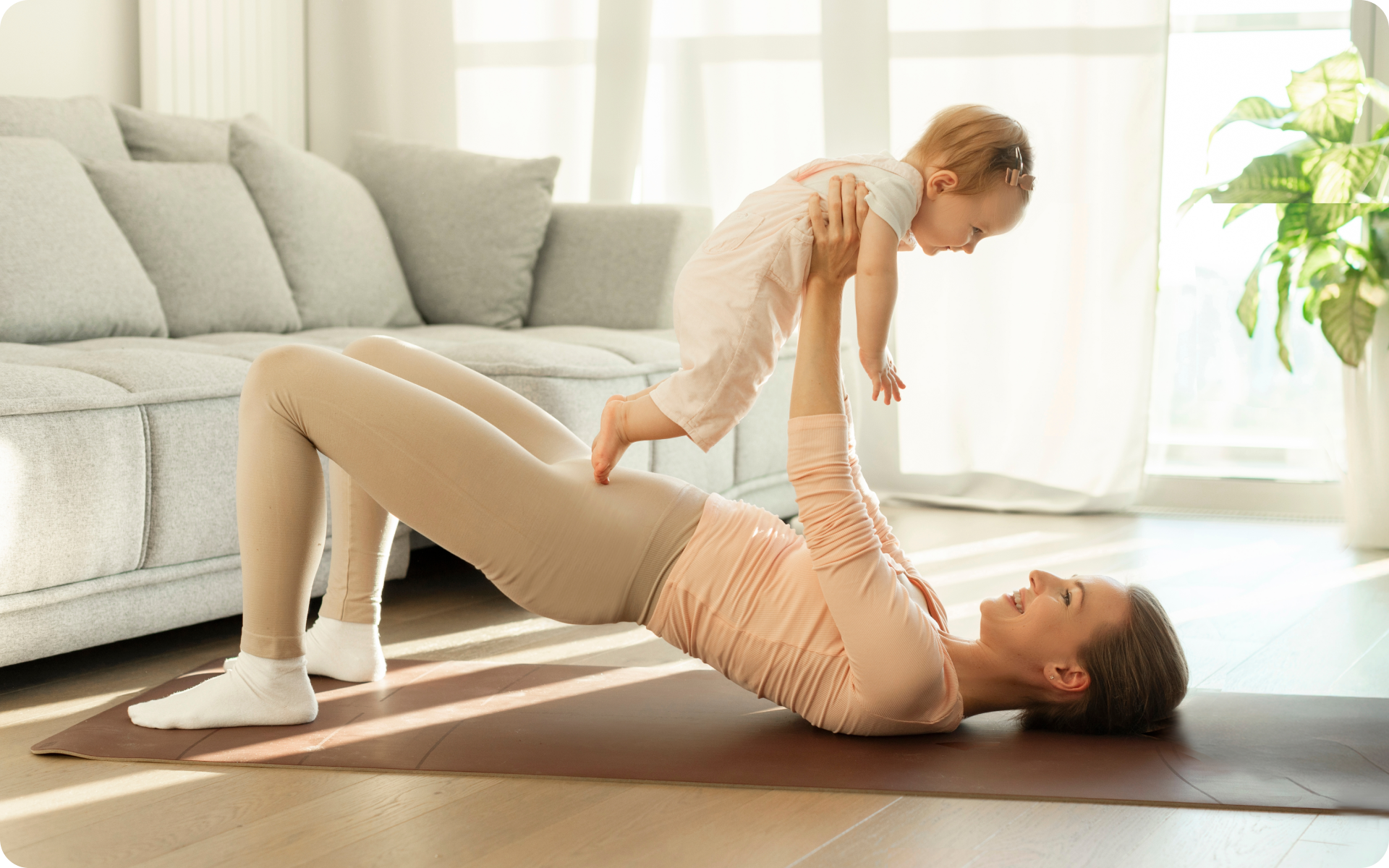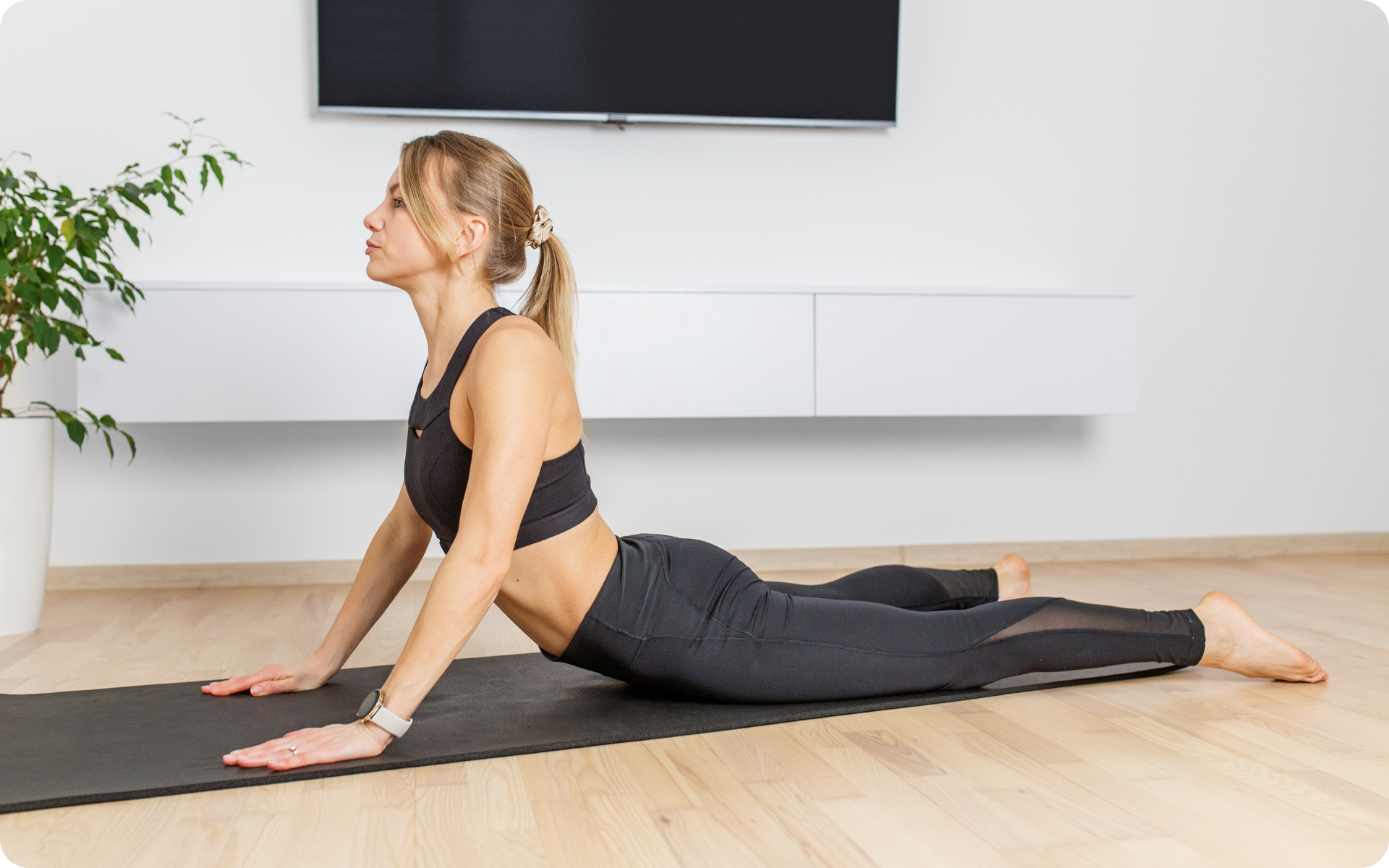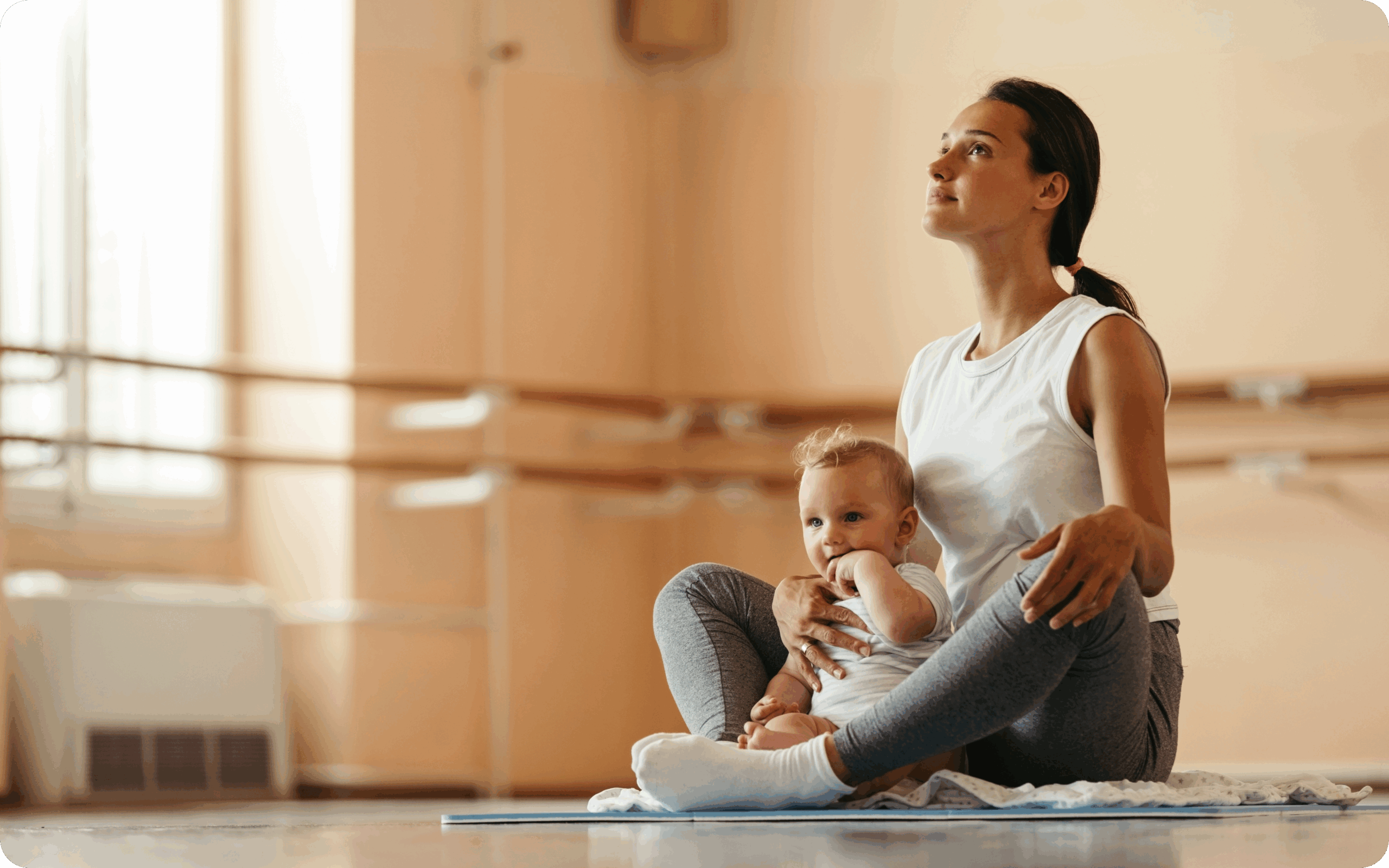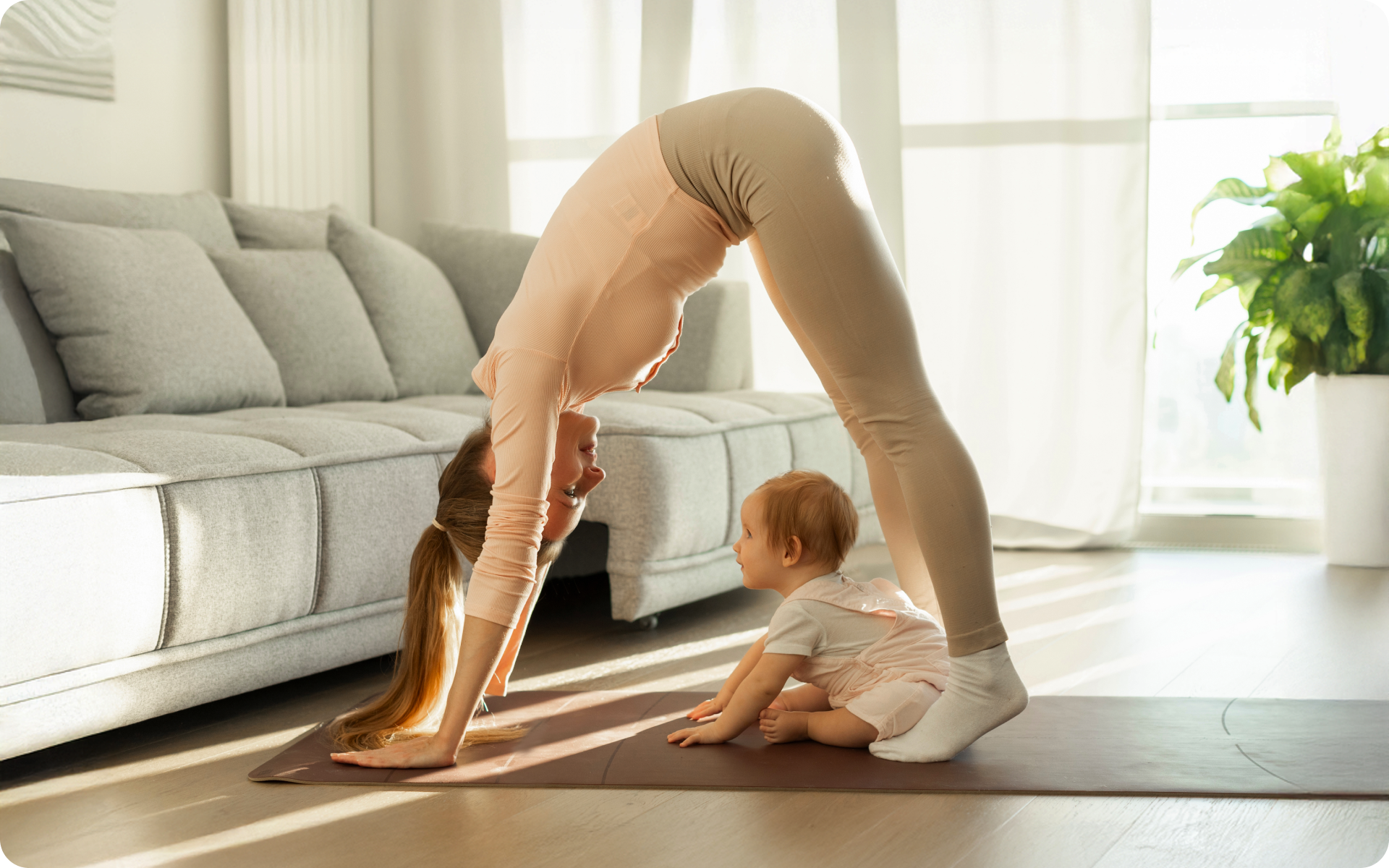The postpartum period, often called the “fourth trimester”, is a time of immense physical and emotional change. While adjusting to life with a newborn, your body is also working hard to recover from pregnancy and childbirth. Finding the right way to support this recovery is key, and postpartum Pilates is an excellent option for new mothers who are looking to rebuild strength, stability, and connection with their bodies.
This guide will walk you through the benefits of Pilates for postpartum recovery, provide expert-backed timelines for returning to exercise, and offer a list of gentle yet effective exercises you can do at home.
We’ll explore how Pilates can help you feel strong and centered, allowing you to navigate the demands of motherhood with greater ease.
Always consult your physician before you start any recovery fitness program to ensure it is suitable for your specific needs.
Is Pilates a Good Postpartum Exercise?
Yes, Pilates can be an excellent form of exercise for the postpartum period. It’s a low-impact method that focuses on strengthening the deep core muscles, improving posture, and enhancing body awareness (1).
Here are eight key reasons why postpartum Pilates is so beneficial for new mothers:
It Supports Your Core and Pelvic Floor
Pregnancy and childbirth place significant strain on your abdominal and pelvic floor muscles (2).
Pilates is renowned for its focus on “centering”, which involves engaging the deep core muscles, including the transversus abdominis and the pelvic floor (3). By helping strengthen these foundational muscles, you can improve stability, reduce back discomfort, and support your pelvic organs, which is essential for long-term health.
It Improves Posture
Carrying a baby for nine months, followed by constantly holding, feeding, and lifting your newborn, can take a toll on your posture. Many new mothers develop rounded shoulders and a forward-leaning head, which can lead to neck and back discomfort (4). Pilates exercises can help correct these imbalances by strengthening the muscles in the back and shoulders (1), helping you stand taller and move more comfortably.
Whether you’re a workout beast or just a beginner making your first foray into the world of fitness and dieting – BetterMe has a lot to offer to both newbies and experts! Install the app and experience the versatility first-hand!
It Focuses on Mindful Breathing
Deep, intentional breathing is a cornerstone of Pilates (5) and offers profound benefits for postpartum recovery. Proper breathing mechanics can help coordinate the diaphragm and pelvic floor (6).
As you inhale, both descend, and as you exhale, they lift. Mastering this connection stimulates your mind, promotes relaxation, and allows your body to recover more effectively. This can also be a powerful tool for the management of stress and worry.
It’s Low-Impact and Gentle
Your body needs time to recover after birth, and high-impact exercises can be too strenuous, particularly during the early weeks. Pilates is a low-impact form of exercise, which means that it’s gentle on your joints (7). This makes it a gentle way to start moving again without putting undue stress on your body as it recovers.
It Enhances Body Awareness
After pregnancy, many women feel disconnected from their bodies. Pilates helps re-establish this connection through slow, controlled movements that require focus and concentration. This enhanced body awareness allows you to move more efficiently and mindfully in your daily life, reducing the risk of injury (8).
It helps relieve everyday tension and discomfort/helps ease aches and discomfort
From a sore back to stiff shoulders, the physical demands of motherhood can cause a variety of aches. Pilates helps alleviate this discomfort by improving flexibility and releasing tension in tight muscles (1, 9). As Pilates founder Joe Pilates famously said, “If your back is inflexibly stiff at 30, you are old. If it is completely flexible at 60, you are young.” (10)
It Can Be Adapted for All Levels
Whether you’re a complete beginner or an experienced practitioner, Pilates can be tailored to suit your fitness level. Postpartum Pilates exercises can be modified to accommodate your recovery stage, which ensures that you’re always working gently and effectively. You can start with simple, foundational movements and progress as you become stronger.
It Supports Energy and Mental Well-being
Although it may seem counterintuitive, gentle exercise can actually boost your energy levels. The American College of Obstetricians and Gynecologists (ACOG) notes that postpartum exercise can help combat fatigue (11). Furthermore, taking time for yourself to move and breathe can be a powerful form of self-care, relieving stress and supporting emotional balance.
Read more: The Real Postpartum Workout Routine Every Mom Needs
How Soon Can I Do Pilates Postpartum?
Returning to exercise after you give birth is a personal journey, and the timeline varies for every woman. The most important thing is to listen to your body and get clearance from your healthcare provider.
According to ACOG, if you had a healthy pregnancy and an uncomplicated vaginal delivery, it’s generally okay to begin gentle exercise a few days after birth, or as soon as you feel ready. If you had a C-section or other complications, you’ll need to wait longer and should consult your doctor to get personalized advice (11).
Here’s a general, progressive timeline of what you might expect:
- Days 1-10: The focus here is on rest, recovery, and gentle connection. You can start with deep breathing exercises (such as scarf breathing), pelvic floor awareness (pelvic floor lifts), and simple movements such as ankle circles and gentle stretches to promote circulation.
- Weeks 2-6: Continue with gentle, low-intensity movements. Walking is an excellent activity during this time. You can incorporate more foundational Pilates exercises such as pelvic tilts and knee drops once you feel comfortable. Avoid strenuous exercise during these first six weeks.
- Weeks 6-12: This is often when many women get the “all-clear” from their doctor at the comprehensive 6-12-week postpartum visit. You can begin to gradually increase the intensity of your workouts. This is a good time to have your abdominal separation (diastasis recti) checked by a professional, such as a women’s health physiotherapist, and start targeted core restore exercises.
- Months 3-6: As you continue to build strength, you can progress to more challenging Pilates exercises. Focus on glute strengthening and continue your deep core work. If you’re interested in returning to high-impact activities such as running, it’s essential to ensure that your pelvic floor is strong enough to handle the load. A physiotherapist can assess your readiness.
Remember, the hormone relaxin, which loosens your ligaments during pregnancy, can remain in your system for several months postpartum, particularly if you’re breastfeeding. This can make you more susceptible to injury, so you should be mindful of overstretching.
What Are the Best Postpartum Pilates Exercises?
Are you ready to get started? Here are some of the best Pilates exercises for postpartum recovery. These movements are designed to be performed at home with just a mat. Remember the “ABCs” of Pilates: alignment, breathing, and centring. Focus on maintaining a neutral back, breathing deeply, and engaging your core throughout each movement.
Pelvic Floor Lift and Pulse
This exercise is fundamental for reconnecting with your pelvic floor.
- Sit upright on a chair or lie on your back in the relaxation position (knees bent, feet flat on the floor).
- After an exhale, gently lift your pelvic floor, as if trying to stop the flow of urine or passing wind. Imagine drawing all four corners of a diamond (tailbone, pubic bone, and both sit bones) together and up.
- Hold the lift for five seconds.
- Release completely as you inhale, allowing your belly and pelvic floor to relax fully.
- Repeat, but this time, after lifting, perform 5 small, quick pulses before releasing. Aim for 6-10 repetitions.
Knee Drops
This move challenges your pelvic stability without straining your abdominals.
- Lie on your back in the relaxation position with a neutral back.
- Inhale to prepare.
- Exhale as you slowly open one knee out to the side, allowing your foot to roll onto its edge. Only go as far as you can without letting your opposite hip lift or shift.
- Inhale to bring the knee back to the starting position.
- Repeat up to 5 times on each side.
Roll Downs Against the Wall
This exercise is great for supporting back mobility and gently engaging the abdominals.
- Stand with your back against a wall, your feet a comfortable distance away, and your knees softly bent.
- Inhale and lengthen your back, nodding your chin toward your chest.
- Exhale and begin to peel your back off the wall, one vertebra at a time, starting from your neck.
- Roll down until you feel a gentle stretch, keeping your bottom against the wall.
- Inhale at the bottom, then exhale to stack your body back up against the wall, vertebra by vertebra.
- Repeat up to 5 times.
Reasons why BetterMe is a safe bet: a wide range of calorie-blasting workouts, finger-licking recipes, 24/7 support, challenges that’ll keep you on your best game, and that just scratches the surface! Start using our app and watch the magic happen.
Cat-Cow
A classic movement for relieving back tension and supporting back flexibility.
- Start on all fours with your hands under your shoulders and your knees under your hips.
- Inhale as you arch your back, lifting your head and tailbone toward the ceiling (cow).
- Exhale as you round your back, tucking your chin and tailbone and drawing your navel toward your back (cat).
- Flow between the two positions for 5-8 breaths.
Legs up the Wall
This is a wonderfully restorative pose that can help reduce temporary puffiness in the legs and promote relaxation.
- Sit on the floor with one hip against a wall.
- Swing your legs up the wall as you lie back, so your butt is as close to the wall as is comfortable.
- Rest your arms by your sides or on your belly.
- Close your eyes and breathe deeply for 5-10 minutes.
Dead Bug
This is a fantastic exercise for building deep core strength without straining your back or neck.
- Lie on your back with your knees bent in a tabletop position (shins parallel to the floor) and your arms extended toward the ceiling.
- Exhale as you slowly lower your right arm and left leg toward the floor. Only lower as far as you can while maintaining a neutral back and keeping your lower back from arching.
- Inhale to return to the starting position.
- Exhale to lower your left arm and right leg.
- Continue alternating for 8-12 repetitions.
Glute Bridge
This exercise strengthens your glutes and hamstrings, which helps support your pelvis and lower back.
- Lie on your back in the relaxation position.
- Exhale as you press through your feet and lift your hips off the floor until your body forms a straight line from your shoulders to your knees.
- Squeeze your glutes at the top.
- Inhale as you slowly lower your hips back down.
- Repeat 10-15 times.
This blog post provides general information and should not be considered medical advice. Always consult a qualified healthcare professional before you start any new exercise program.
Are you ready to build a stronger foundation for motherhood? Learn more about the benefits of pelvic floor Pilates.
Read more: Weight Loss After Pregnancy: Why, When, and How According to Research
What Pilates Moves Should I Avoid Postpartum?
While Pilates is generally gentle, certain exercises can place too much strain on a recovering body and may worsen conditions such as diastasis recti. It’s best to avoid these movements until you’ve rebuilt your foundational strength, ideally with guidance from a postnatal-trained instructor or physiotherapist.
Moves to be cautious with include:
- Traditional Crunches and Sit-ups: These can increase intra-abdominal pressure and place stress on the linea alba.
- The Hundred (Classical Version): The full version with legs extended low can be too challenging for the postpartum core. A modified version with your knees bent is a better starting point.
- Double Leg Stretches: Similar to the hundred, this exercise can over-tax the abdominal muscles if it’s not performed with a strong, stable core.
- Planks: While great for core strength, a full plank may be too intense initially. Modified planks on your knees are a more gentle alternative.
- Roll-Ups and Roll-Overs: These advanced back flexion movements require significant core strength and control.
The key is to progress slowly and listen to your body. If you feel any discomfort, pressure, or see your abdomen “doming” or “coning” along the midline, this is a sign that the exercise is too advanced for you right now.
Did you know that you can build core stability without traditional ab exercises? Discover how to work on pelvic floor muscles without kegels.
Yes, Pilates is highly recommended for a postpartum journey. It’s a low-impact exercise method that strengthens the deep core, improves posture, increases flexibility, and enhances mind-body awareness (1), all of which are essential for new mothers. If you’re interested in how Pilates can support your postpartum fitness goals, you may also want to explore whether reformer Pilates is good for weight loss. No single exercise can spot-reduce belly fat. Fat loss is achieved through a combination of consistent, whole-body exercise and a balanced diet that creates a caloric deficit (12). High-intensity interval training (HIIT) and compound strength exercises (such as squats and deadlifts) are effective for burning calories and building muscle, which can support your metabolism (13). However, for postpartum women, it’s important to first rebuild foundational core strength with exercises such as Pilates before progressing to higher-intensity workouts. Both yoga and Pilates are excellent for building a toned physique, but they achieve it in different ways. Pilates typically is focused on building strength in the deep, stabilizing muscles of the core through controlled, repetitive movements, often using resistance from springs (on a reformer) or your own body weight (1). Yoga tends to focus more on holding static poses (asanas) and flowing between them, which builds strength, balance, and flexibility (14). The “best” choice will depend on your personal goals and preferences.Frequently Asked Questions
Is Pilates good for your postpartum journey?
What exercise burns the most belly fat in a female?
Do you get more toned from yoga or Pilates?
The Bottom Line
Starting a postpartum Pilates practice is a powerful way to support your body’s recovery journey, helping you feel stronger, more connected, and better equipped for the beautiful challenges of motherhood. By focusing on alignment, breathing, and core engagement, you can rebuild your foundation from the inside out.
Remember to be patient and compassionate with yourself. Your body has done something incredible, and recovery takes time. Celebrate the small victories and enjoy the process of rediscovering your strength.
DISCLAIMER:
This article is intended for general informational purposes only and does not serve to address individual circumstances. It is not a substitute for professional advice or help and should not be relied on for making any kind of decision-making. Any action taken as a direct or indirect result of the information in this article is entirely at your own risk and is your sole responsibility.
BetterMe, its content staff, and its medical advisors accept no responsibility for inaccuracies, errors, misstatements, inconsistencies, or omissions and specifically disclaim any liability, loss or risk, personal, professional or otherwise, which may be incurred as a consequence, directly or indirectly, of the use and/or application of any content.
You should always seek the advice of your physician or other qualified health provider with any questions you may have regarding a medical condition or your specific situation. Never disregard professional medical advice or delay seeking it because of BetterMe content. If you suspect or think you may have a medical emergency, call your doctor.
SOURCES:
- Pilates: how does it work and who needs it? (2011, pmc.ncbi.nlm.nih.gov)
- Urogynecology in obstetrics: impact of pregnancy and delivery on pelvic floor disorders, a prospective longitudinal observational pilot study (2021, link.springer.com)
- Pilates and the “powerhouse”—I (2004, sciencedirect.com)
- Mom posture (2019, nwh.northwell.edu)
- Pilates: What Is It? Should It Be Used in Rehabilitation? (2011, pmc.ncbi.nlm.nih.gov)
- How Should You Breathe? – Julie Wiebe PT (n.d., juliewiebept.com)
- PILATES EXERCISES, TYPES, AND ITS IMPORTANCE: AN OVERVIEW (2023, researchgate.net)
- Pilates 101: What It Is and Health Benefits (2023, health.clevelandclinic.org)
- Pilates for Improvement of Muscle Endurance, Flexibility, Balance, and Posture (2010, journals.lww.com)
- PILATES’ – Return to Life Through Contrology (1945, books.out.csli.me)
- Physical Activity and Exercise During Pregnancy and the Postpartum Period (2015, acog.org)
- “Calories in, calories out” and macronutrient intake: the hope, hype, and science of calories (2017, journals.physiology.org)
- Evidence-Based Effects of High-Intensity Interval Training on Exercise Capacity and Health: A Review with Historical Perspective (2021, pmc.ncbi.nlm.nih.gov)
- Exploring the therapeutic effects of yoga and its ability to increase quality of life (2011, pmc.ncbi.nlm.nih.gov)
